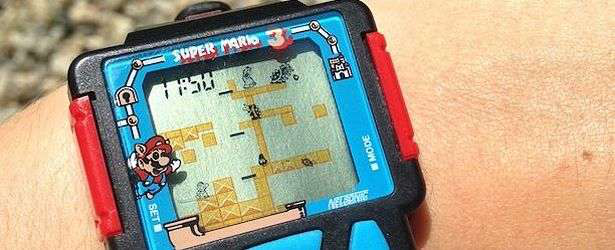Mario Kart 8 – Preview
by Edward

|
 There’s nothing quite like it, is there? The roar of the engines, the burning of rubber, the cheers as you pass competitor after competitor, the intense wheel-to-wheel action with your rival as you both know only one of you can make it through the next corner first. Then there’s the intense, last-gasp victories, the crushing defeats, and the glorious moment when it all pays off, you take to the podium and lift the cup above all as a token that all your hard work has finally paid off. Ladies and gentlemen, welcome to Mario Kart.
There’s nothing quite like it, is there? The roar of the engines, the burning of rubber, the cheers as you pass competitor after competitor, the intense wheel-to-wheel action with your rival as you both know only one of you can make it through the next corner first. Then there’s the intense, last-gasp victories, the crushing defeats, and the glorious moment when it all pays off, you take to the podium and lift the cup above all as a token that all your hard work has finally paid off. Ladies and gentlemen, welcome to Mario Kart.
Ever since the second Mario Kart arrived on the N64, I’ve been an obsessive fan of the series, with the only entry since that I haven’t completely demolished being Double Dash!, through a combination of never being quite able to get the hang of the two racers at once mechanic and never actually owning a Gamecube. With the amount of hours I’ve sunk into the series I could have mastered playing a musical instrument, become adept at some kind of sport or written the great American novel, but it’s still my first choice when playing with others, and I can still be found muttering under my breath trying to master the time trials whenever I have a spare moment. So with that in mind, is it really that big a surprise that Mario Kart 8 picks up one of my three coveted “Game of E3″ awards? Surely all they’d have to do is just make the same thing over again, slap a different number on it and I’d go buy it and invest hundreds of hours regardless? Well, that may be true, yet Nintendo haven’t rested on their laurels, but have instead laid the groundwork for what could easily end up as the best in the series.
Developed in-house by the same team that gave us Mario Kart DS and Wii – arguably the console and hand-held pinnacles of the series – EAD Group 1 have been tirelessly at work on Mario Kart 8 to get it ready in time for its release early next year, and even with a three-track demo it was clear just how much effort had been put into the series, to the point that it was already in a state where I found it nearly impossible to put down. A return to twelve participants per race meant that there was already a large, familiar roster of characters to choose from, with some taking to the titular karts and others hopping on motorbikes, which make a return to the series after their absence in 7. They were controversial addition back when they first appeared on the Wii, owing both to the fact that they weren’t karts and their ability to pop a wheelie on straights for an extra speed boost was one that many felt unbalanced the action unfairly in their favour, even if getting hit when trying to do so would disadvantage you far more, especially thanks to their sub-par acceleration.
 Since then, it seems as if the bikes have lost their ability to wheelie – I was unable to get any of the racers I used to perform one outside of using a mushroom boost, in any case – but have gained both levels of drift boost back, having previously only been able to get the smaller mini-boost as another method to balance out their straight-line boosts. While their excision can be cited as a way to balance the vehicles further, there’s another, potentially simpler explanation at hand; taking more than a few cues from that other Nintendo racing series F-Zero, all the karts and bikes now have anti-gravity installed, allowing you to literally drive them up the wall.
Since then, it seems as if the bikes have lost their ability to wheelie – I was unable to get any of the racers I used to perform one outside of using a mushroom boost, in any case – but have gained both levels of drift boost back, having previously only been able to get the smaller mini-boost as another method to balance out their straight-line boosts. While their excision can be cited as a way to balance the vehicles further, there’s another, potentially simpler explanation at hand; taking more than a few cues from that other Nintendo racing series F-Zero, all the karts and bikes now have anti-gravity installed, allowing you to literally drive them up the wall.
All of the tracks I have a chance to try out employed this new feature in some way, whether it was providing an alternative route in the Ghost House, an optional short-cut in the Plaza, or the figure-eight circuit that turns into the Möbius strip present in the title’s logo. Though it could easily have come off as a gimmick, it instead opens up the track designs in a ingeniously inventive manner, and allows the developers to provide tracks that they truly couldn’t have done before.
An offset of these track designs is one that is more than entirely welcome to me – an emphasis on driver skill, rather than luck. This can also be attributed to the fact that the demo was lacking the full roster of weapons and items that the drivers can use, with only bananas, mushrooms and red and green shells available, with the almost universally-despised Blue Shell nowhere to be seen (I’d like to take this moment to make a public appeal: please Nintendo, whatever you do please don’t bring back the blue shell). Though all the items have yet to be finalised, it seemed like there were only a few item boxes on each circuit I tried out, and I’m sincerely hoping that it stays that way for the final release. The reason for this is twofold; one of the major problems with Mario Kart Wii was that frequent item-boxes – combined with twelve racers at once – often resulted in absolute chaos and a horrendous time for anyone who dared to take the lead, and it also means a greater emphasis on driver skill in order to reach the front of the pack, rather than lucking out with items.
In fact, that last reason is precisely why I found myself so enamoured with Mario Kart 8; every change I saw – especially in terms of handling and track design – put a greater emphasis on driver skill and your own abilities, and so every victory felt satisfying and well-earned. Granted, it’s fully possible that between now and its release next year that things could change; tracks could become shallow anti-gravity gimmicks, new items could spring forward that put make victory more about luck than skill, and the blue shell could be even worse than before. Yet, from what I played, everything seemed to be sliding into place almost perfectly to the point I’m still suffering from withdrawal symptoms weeks after the fact.
 |
 |
 |
 |
 |
 |
Most of this is down to the handling, as over several demos with a variety of different characters and vehicles I found it to be absolutely sublime, perfectly responsive and an utter joy to play. Every racer felt suitably different, with bikes in particular still uniquely distinct from the karts, giving players enough of an incentive to try them out even if they’re lacking the power to wheelie. Drifting in particular has been given another overhaul, with the closest comparison I can give being that it’s more reminiscent of Mario Kart Wii with the time needed to boost being slightly closer to Mario Kart 7. My biggest problem with the series’ 3DS outing is that in an attempt to prevent the snaking epidemic that plagued Mario Kart DS, boosts could only be achieved by drifting for what felt like entire seconds before you would even see the blue sparks, let alone the preferable red ones, which made performing them a trickier art than they should have been. With that in mind, that Mario Kart 8 is approaching drifting in a way that’s closer to its last console counterpart rather then the last hand-held outing is a design choice that suits me perfectly.
 Mario Kart 8 can be controlled in a variety of ways, from the Wii U pro controller to the Wiimote and nunchuk combination and the traditional Wii Wheel, as well as the standard gamepad. Opting to favour the gamepad control scheme over the rest allowed me to get to grips with what will be the standard way to play for many, and one that I found preferable to using the alternative Wiimote controls. The controls are well-suited the for gamepad, and though Off-TV play will be available in the final release, for now the touch-screen just displayed the map and the positions of everyone else in the race. Interestingly, you can also decide whether to control your kart via motion controls or the traditional buttons, and this could be altered just by tapping the option on the touch-screen at any time, and – in a hilarious piece of pointlessness – activating the touch controls would also let you honk your horn by tapping and holding the wheel on your gamepad screen.
Mario Kart 8 can be controlled in a variety of ways, from the Wii U pro controller to the Wiimote and nunchuk combination and the traditional Wii Wheel, as well as the standard gamepad. Opting to favour the gamepad control scheme over the rest allowed me to get to grips with what will be the standard way to play for many, and one that I found preferable to using the alternative Wiimote controls. The controls are well-suited the for gamepad, and though Off-TV play will be available in the final release, for now the touch-screen just displayed the map and the positions of everyone else in the race. Interestingly, you can also decide whether to control your kart via motion controls or the traditional buttons, and this could be altered just by tapping the option on the touch-screen at any time, and – in a hilarious piece of pointlessness – activating the touch controls would also let you honk your horn by tapping and holding the wheel on your gamepad screen.
In many ways, it feels like Mario Kart 8 has taken all of the lessons that could be learnt from the Wii and 3DS iterations and has provided an edition of the series that eliminates all of those problem and builds further on the best features. Coins and the customisation of karts – one of the best aspects of 7 and one of the main reasons I’m still unable to put it down – remain from the last outing, and though the vehicles couldn’t be tinkered with in the demo the coins were present, and getting the maximum amount per race wasn’t a guarantee like last time, where reaching the end without filling your quota meant that something had seriously gone wrong. Also staying over from the 3DS racer are the para-gliders and underwater racing, with the glider in particular feeling quite different when used on the Möbius strip track, as the handling was a great deal floatier and slower than it was on the hand-held The series janitor Lakitu is still around to put you back on the track when you fall in the drink or hit a bottomless hole, but he’s also far quicker to recover you, and when I mistimed a drift that sent me careening into the water I was racing within a fraction of the time it would have taken me in any of the previous Mario Karts.
As the most iconic Mario franchise after his platforming antics, there’s always a great deal of attention that comes with every iteration of Mario Kart, but the Wii U outing easily looks like it could be the best yet. The track designs are inventive and place a greater emphasis on skill rather than who can fire off their weapons the fastest, the anti-gravity is employed in a great way that doesn’t come off as a gimmick, and the handling is the greatest its ever been. Those who’ve never been one for the series may find themselves yet converted, and those who consider themselves fans should get seriously excited, because if it continues the way it’s been going then Mario Kart 8 is the closest the series has ever been to perfection.
Last five articles by Edward
- Best of 2015: Journey's End: A New Beginning
- Journey's End: A New Beginning
- You Can't Choose Your Happy Ending
- Okay, Let's Fix Comedy In Games - The V-Effekt
- Time Keeps On Smashing Away

























Have you noticed that Mario’s tyres have the ‘Mario M’ as the tyre tread pattern? Think that’s a decent indication towards the level of detail on show.